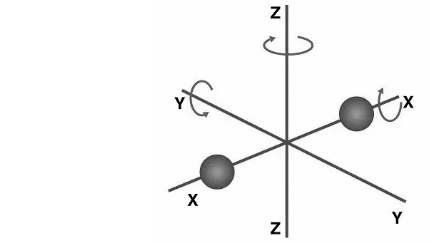The equipartition theorem connects a system’s temperature to its average energy. The original concept of equipartition was that energy is shared equally across all of its forms in thermal equilibrium; for example, the average kinetic energy per degree of freedom in a molecule’s translational motion should equal that of its rotating motion. A single atom can freely move along the X, Y, and Z axes in space. Each of these actions, however, necessitates the expenditure of energy. This is derived from the atom’s stored energy. The Law of Energy Equipartition determines how much energy is allocated to each atom’s motion (translational, rotational and vibrational).
Degree of freedom
- Take a look at a single atom. It may freely move along the X, Y, and Z axes in three-dimensional space. Translation is the process of moving from one point to another. As a result, translational movement is defined as movement along three axes. If you need to specify this atom’s location, you’ll need three coordinates (x, y, and z). A single atom can also be said to have three degrees of freedom. Most monoatomic molecules (molecules with only one atom, such as Argon) have three translational degrees of freedom if they may move freely.
- Consider a diatomic molecule for a moment (a molecule having two atoms like O2 or N2). These molecules can rotate about the centre of mass in addition to the three translational degrees of freedom. Along the axis normal to the axis that connects the two atoms, two such rotations are feasible.This gives the molecule two more degrees of freedom (rotational). To put it another way, the X, Y, and Z coordinates, as well as the rotational coordinates of the individual atoms, are required to identify the molecule’s location.
- It is vital to highlight that at all temperatures, these diatomic molecules are not hard rotators (molecules that do not vibrate). Diatomic molecules vibrate along the interatomic axis like a single-dimensional oscillator in addition to translational and rotational movements. Such molecules gain a vibrational degree of freedom as a result of this.
- As a result, the X, Y, and Z coordinates, as well as the rotational and vibrational coordinates, are required to identify the location of a diatomic molecule. In a nutshell, Degrees of Freedom refers to the number of different ways that a molecule can move. The Law of Energy Equipartition is founded on this principle.
Types of molecules | N | Degree of freedom | Modes |
monoatomic | 1 | 3 | 3 transitional 0 rotational 0 vibrational |
diatomic | 2 | 6 | 3 transitional 2 rotational 1 vibrational |
Triatomic linear | 3 | 9 | 3 transitional 2 rotational 4 vibrational |
Triatomic non linear | 3 | 9 | 3 transitional 3 rotational 3 vibrational |
Law of equipartition of energy equation
For every dynamic system in thermal equilibrium, the law of energy equipartition is defined as the equal distribution of energy among the degrees of freedom.
Let’s look at how kinetic energy is distributed evenly in a single molecule along the x, y, and z axes.
- X – Axis =1/2 mvx2
- Y – Axis =1/2 mvy2
- Z-Axis = 1/2 mvz2
When a gas is at thermal equilibrium, its average kinetic energy is expressed as.
- X – Axis =1/2 mvx2
- Y-Axis =1/2 mvy2
- Z-Axis = 1/2 mvz2
the average kinetic energy is expressed as.
The Boltzmann constant is written as Kb, while vrms is the square root of the molecules’ velocity.The temperature of the gas is denoted by the letter T.

What is equipartition of energy:
The concept behind equipartition is that, under thermal equilibrium, the energy of a system is equally shared among all the forms of energy. This means that the average kinetic energy for each degree of freedom will be equal in both translational motion and rotational motion.
Applications
- The equipartition theorem is useful in the case of ideal gases.From Newtonian mechanics, equipartition is used to construct the classical ideal gas law. The equipartition theorem makes it simple to find the laws that apply to an extreme relativistic ideal gas.
- The equipartition theorem can also be used to calculate the energy and pressure of “non-ideal gases,” in which the particles interact with conservative forces whose potential U(r) is solely determined by the distance r between them.
- In contrast to a simple harmonic oscillator, a harmonic oscillator has a potential energy that is not quadratic in the extension q. These oscillators offer a different perspective on the equipartition theorem.
- In astronomy, the equipartition theorem and the related virial theorem have long been utilised as tools.
- The equipartition theorem can be used to calculate a particle’s Brownian motion using the Langevin equation.
- The same methods can be used to calculate star formation conditions in massive molecular clouds.
Conclusion
In classical statistical mechanics, the equipartition theorem ties a system’s temperature to its average energy. The equipartition theorem is also known as the law of equipartition, energy equipartition, or simply equipartition. The original concept of equipartition was that in thermal equilibrium, energy is distributed evenly among all of its forms; for example, in translational motion, the average kinetic energy per degree of freedom should be equal to that in rotating motion. The equipartition theorem is used to make quantitative predictions. Similar to the virial theorem, it provides the total average kinetic and potential energies for a system at a given temperature, from which the system’s heat capacity can be derived.
 Profile
Profile Settings
Settings Refer your friends
Refer your friends Sign out
Sign out




